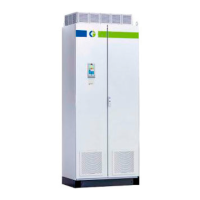CG Drives & Automation, 01-5326-01r5 Installation 45
3.5 Thermal protection on the
motor
Standard motors are normally fitted with an internal fan.
The cooling capacity of this built-in fan is dependent on the
frequency of the motor. At low frequency, the cooling
capacity will be insufficient for nominal loads. Please
contact the motor supplier for the cooling characteristics of
the motor at lower frequency.
Motor thermistors offer better thermal protection for the
motor. Depending on the type of motor thermistor fitted,
the optional PTC input may be used. The motor thermistor
gives a thermal protection independent of the speed of the
motor, thus of the speed of the motor fan. See the functions,
Motor I
2
t type [231] and Motor I
2
t current [232].
3.6 Motors in parallel
The Drive Mode "Speed" or "Torque", see menu [213],
performs very well in most applications based on the direct
torque control as motor control method. However in
applications with multiple motors connected in parallel to
the AC drive output one should select Drive Mode = "V/
Hz" and then it is possible to have motors in parallel as long
as the total current does not exceed the nominal value of the
AC drive. The following has to be taken into account when
setting the motor data:
WARNING!
Depending on the cooling characteristics
of the motor, the application, the speed
and the load, it may be necessary to use
forced cooling on the motor.
Menu [221]
Motor Voltage:
The motors in parallel must have the
same motor voltage.
Menu [222]
Motor
Frequency:
The motors in parallel must have the
same motor frequency.
Menu [223]
Motor Power:
Add the motor power values for the
motors in parallel.
Menu [224]
Motor Current:
Add the current for the motors in parallel.
Menu [225]
Motor Speed:
Set the average speed for the motors in
parallel.
Menu [227]
Motor Cos PHI:
Set the average Cos PHI value for the
motors in parallel.

